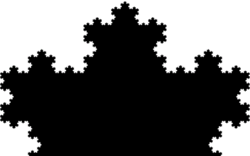

In mathematics, a self-similar object is exactly or approximately similar to a part of itself (i.e., the whole has the same shape as one or more of the parts). Many objects in the real world, such as coastlines, are statistically self-similar: parts of them show the same statistical properties at many scales.[2] Self-similarity is a typical property of fractals. Scale invariance is an exact form of self-similarity where at any magnification there is a smaller piece of the object that is similar to the whole. For instance, a side of the Koch snowflake is both symmetrical and scale-invariant; it can be continually magnified 3x without changing shape. The non-trivial similarity evident in fractals is distinguished by their fine structure, or detail on arbitrarily small scales. As a counterexample, whereas any portion of a straight line may resemble the whole, further detail is not revealed.
A time developing phenomenon is said to exhibit self-similarity if the numerical value of certain observable quantity measured at different times are different but the corresponding dimensionless quantity at given value of remain invariant. It happens if the quantity exhibits dynamic scaling. The idea is just an extension of the idea of similarity of two triangles.[3][4][5] Note that two triangles are similar if the numerical values of their sides are different however the corresponding dimensionless quantities, such as their angles, coincide.
Peitgen et al. explain the concept as such:
If parts of a figure are small replicas of the whole, then the figure is called self-similar....A figure is strictly self-similar if the figure can be decomposed into parts which are exact replicas of the whole. Any arbitrary part contains an exact replica of the whole figure.[6]
Since mathematically, a fractal may show self-similarity under indefinite magnification, it is impossible to recreate this physically. Peitgen et al. suggest studying self-similarity using approximations:
In order to give an operational meaning to the property of self-similarity, we are necessarily restricted to dealing with finite approximations of the limit figure. This is done using the method which we will call box self-similarity where measurements are made on finite stages of the figure using grids of various sizes.[7]
This vocabulary was introduced by Benoit Mandelbrot in 1964.[8]
- ^ Mandelbrot, Benoit B. (1982). The Fractal Geometry of Nature, p.44. ISBN 978-0716711865.
- ^ Mandelbrot, Benoit B. (5 May 1967). "How long is the coast of Britain? Statistical self-similarity and fractional dimension". Science. New Series. 156 (3775): 636–638. Bibcode:1967Sci...156..636M. doi:10.1126/science.156.3775.636. PMID 17837158. S2CID 15662830. Archived from the original on 19 October 2021. Retrieved 12 November 2020. PDF
- ^ Hassan M. K., Hassan M. Z., Pavel N. I. (2011). "Dynamic scaling, data-collapseand Self-similarity in Barabasi-Albert networks". J. Phys. A: Math. Theor. 44 (17): 175101. arXiv:1101.4730. Bibcode:2011JPhA...44q5101K. doi:10.1088/1751-8113/44/17/175101. S2CID 15700641.
{{cite journal}}: CS1 maint: multiple names: authors list (link) - ^ Hassan M. K., Hassan M. Z. (2009). "Emergence of fractal behavior in condensation-driven aggregation". Phys. Rev. E. 79 (2): 021406. arXiv:0901.2761. Bibcode:2009PhRvE..79b1406H. doi:10.1103/physreve.79.021406. PMID 19391746. S2CID 26023004.
- ^ Dayeen F. R., Hassan M. K. (2016). "Multi-multifractality, dynamic scaling and neighbourhood statistics in weighted planar stochastic lattice". Chaos, Solitons & Fractals. 91: 228. arXiv:1409.7928. Bibcode:2016CSF....91..228D. doi:10.1016/j.chaos.2016.06.006.
- ^ Peitgen, Heinz-Otto; Jürgens, Hartmut; Saupe, Dietmar; Maletsky, Evan; Perciante, Terry; and Yunker, Lee (1991). Fractals for the Classroom: Strategic Activities Volume One, p.21. Springer-Verlag, New York. ISBN 0-387-97346-X and ISBN 3-540-97346-X.
- ^ Peitgen, et al (1991), p.2-3.
- ^ Comment j'ai découvert les fractales, Interview de Benoit Mandelbrot, La Recherche https://www.larecherche.fr/math%C3%A9matiques-histoire-des-sciences/%C2%AB-comment-jai-d%C3%A9couvert-les-fractales-%C2%BB

